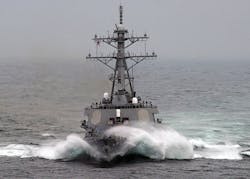Navy bulks-up anti-submarine warfare (ASW) capability for surface warships
WASHINGTON — Undersea warfare experts at the Lockheed Martin Corp. Rotary and Mission Systems segment in Manassas, Va., will provide the U.S. Navy with AN/SQQ-89A(V)15 anti-submarine warfare (ASW) systems for surface warships under terms of a $77.8 million order announced in January.
Officials of the Naval Sea Systems Command in Washington are asking Lockheed Martin for production of the Navy’s AN/SQQ-89A(V)15 surface ship undersea warfare systems.
The AN/SQQ-89A(V)15 is an undersea combat system that enables surface warships to search, detect, classify, localize, and track underwater contacts, and to attack or avoid enemy submarines, floating, tethered, or bottom-attacked mines, and torpedoes.
Lockheed Martin is providing the U.S. Navy with AN/SQQ-89A(V)15 anti-submarine warfare (ASW) systems for surface warships like the Arleigh Burke-class destroyer, shown above.
The order is for development, integration, and production of future advanced-capability build and technical-insertion baselines of AN/SQQ-89A(V)15 undersea warfare systems.
The AN/SQQ-89A(V)15 uses active and passive sonar to enable Navy Arleigh Burke-class destroyers and Ticonderoga-class cruisers to detect, locate, track, and attack hostile submarines, mines, and torpedoes.
The system provides multi-sensor track correlation and target track management control, and forwards data to the ship’s weapons and decision-support systems. The AN/SQQ-89A(V)15 works together with the ship’s active and passive hull sonar, multi-function towed array, sonobuoy processing, torpedo alerts, fire-control system, sensor performance predictions, embedded operator, and team training systems.
The AN/SQQ-89A(V)15 has an open electronics architecture to accommodate system upgrades, and makes the most of data accessibility and system modules, Lockheed Martin officials say. Its software application programs are isolated from hardware.
Virtual Network Computing (VNC) enables rapid re-allocation of operator console displays to suit the tactical situation, Lockheed Martin officials say.
Recent and planned upgrades to the AN/SQQ-89A(V)15 include improved automated torpedo detection, sonar performance prediction, advanced active sonar processing, re-designed active displays to reduce operator loading, and integrated training and logistics.
The AN/SQQ-89 is integrated with the Aegis combat system, vertical launch anti-submarine rocket (ASROC) system. A variant of the AN/SQQ-89A(V)15 is integrated with late-version Aegis combat systems being installed onboard new Arleigh Burke-class destroyers. A back-fit program is in place to retrofit existing DDG-51 class ships and Ticonderoga-class cruisers.
On this order Lockheed Martin will do the work in Lemont Furnace, Pa.; Clearwater, Fla.; Syracuse, Hauppauge, and Owego, N.Y.; Manassas, Va.; and Tewksbury, Mass., and should be finished by May 2021.
For more information contact Lockheed Martin Rotary and Mission Systems online at www.lockheedmartin.com, or Naval Sea Systems Command at www.navsea.navy.mil.

